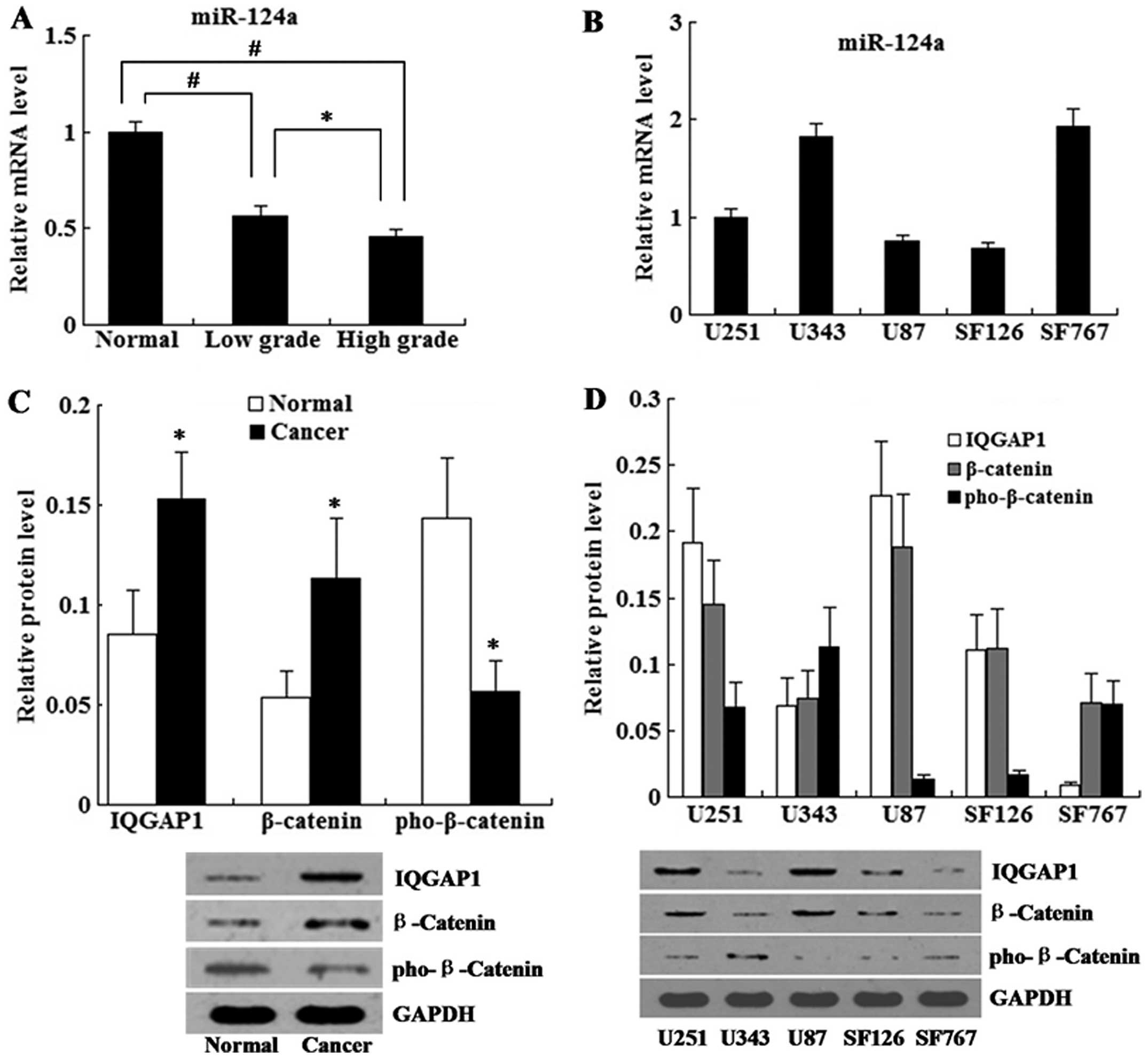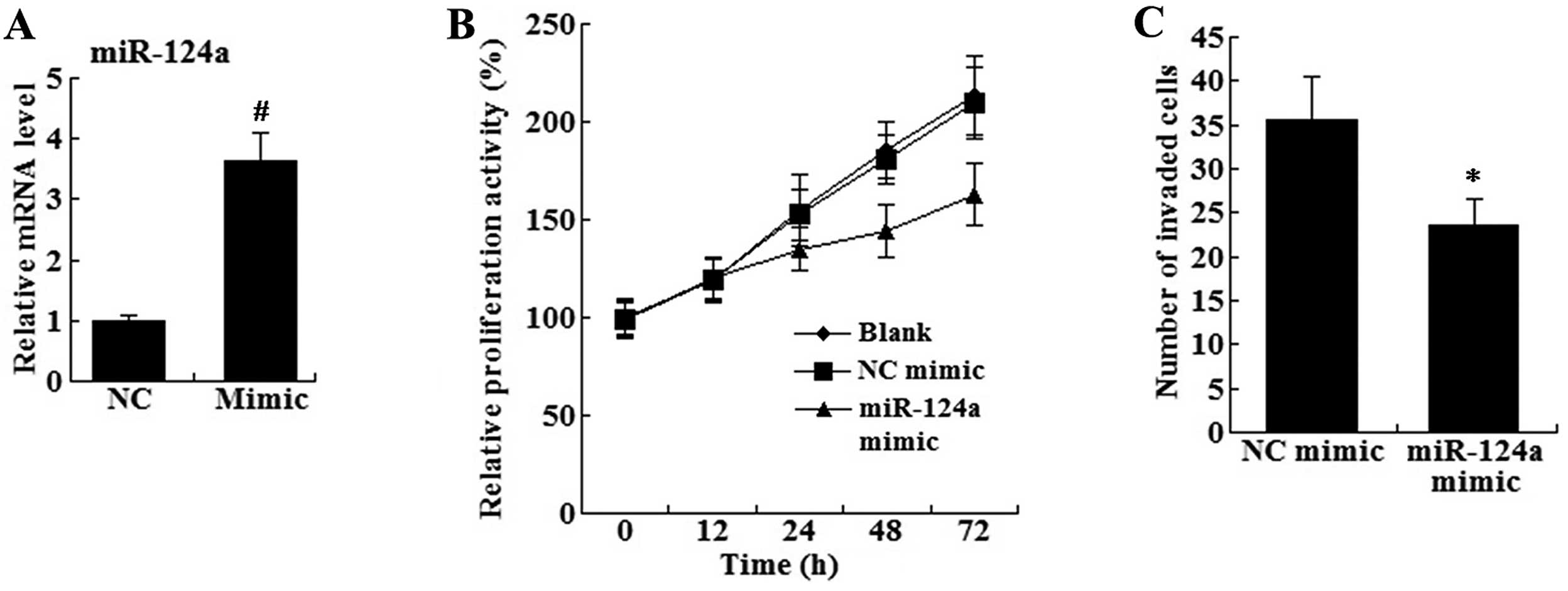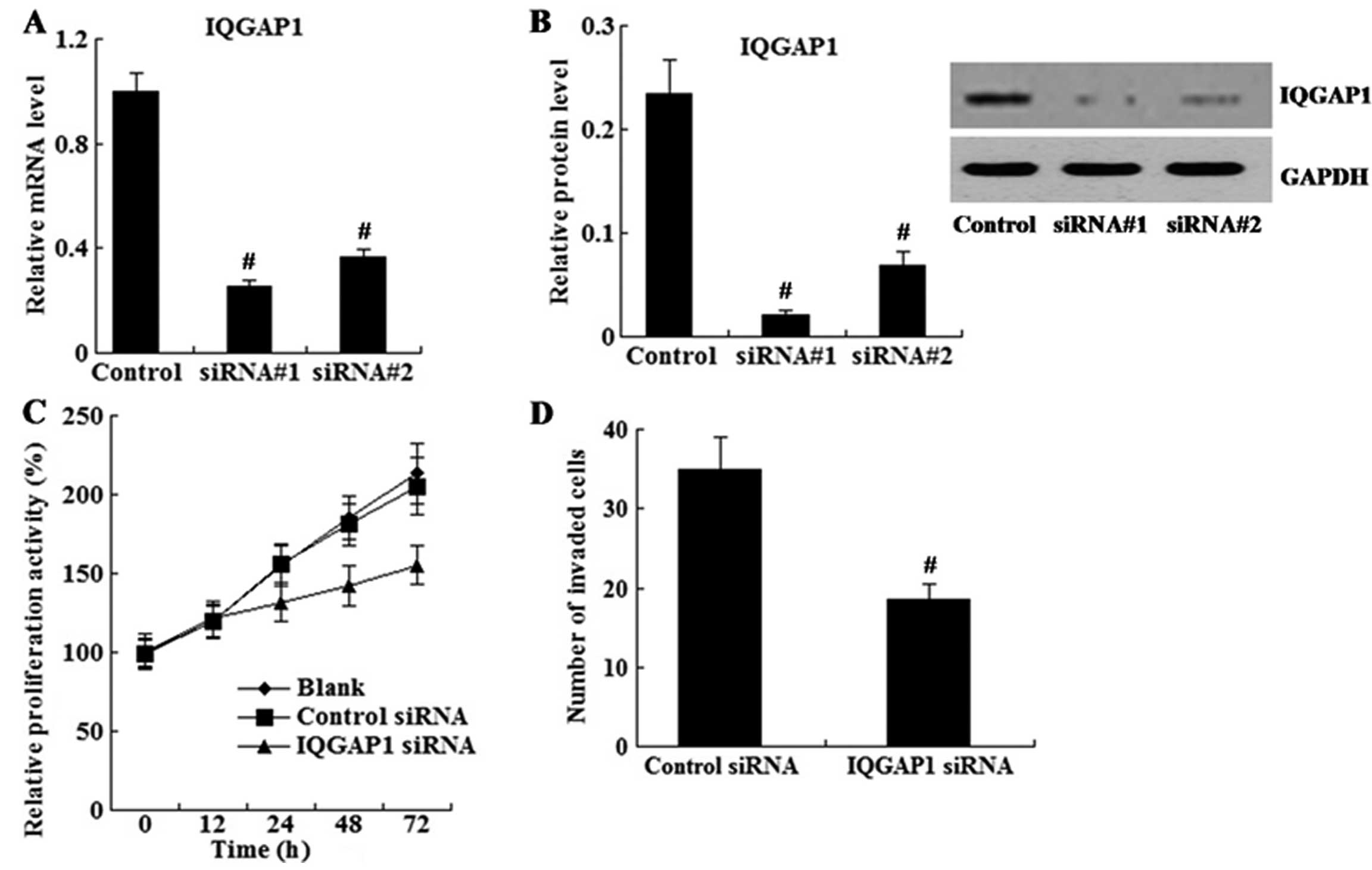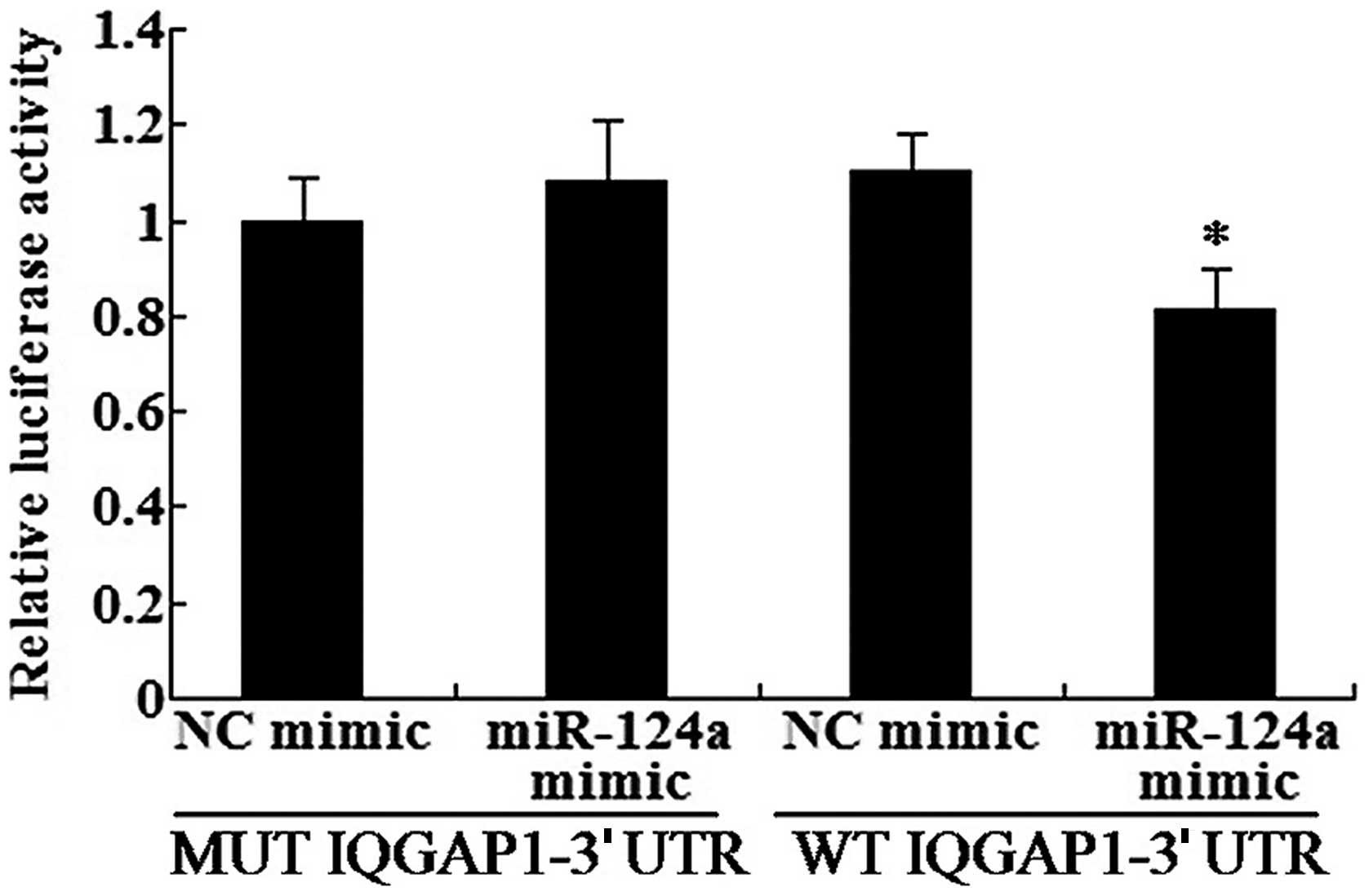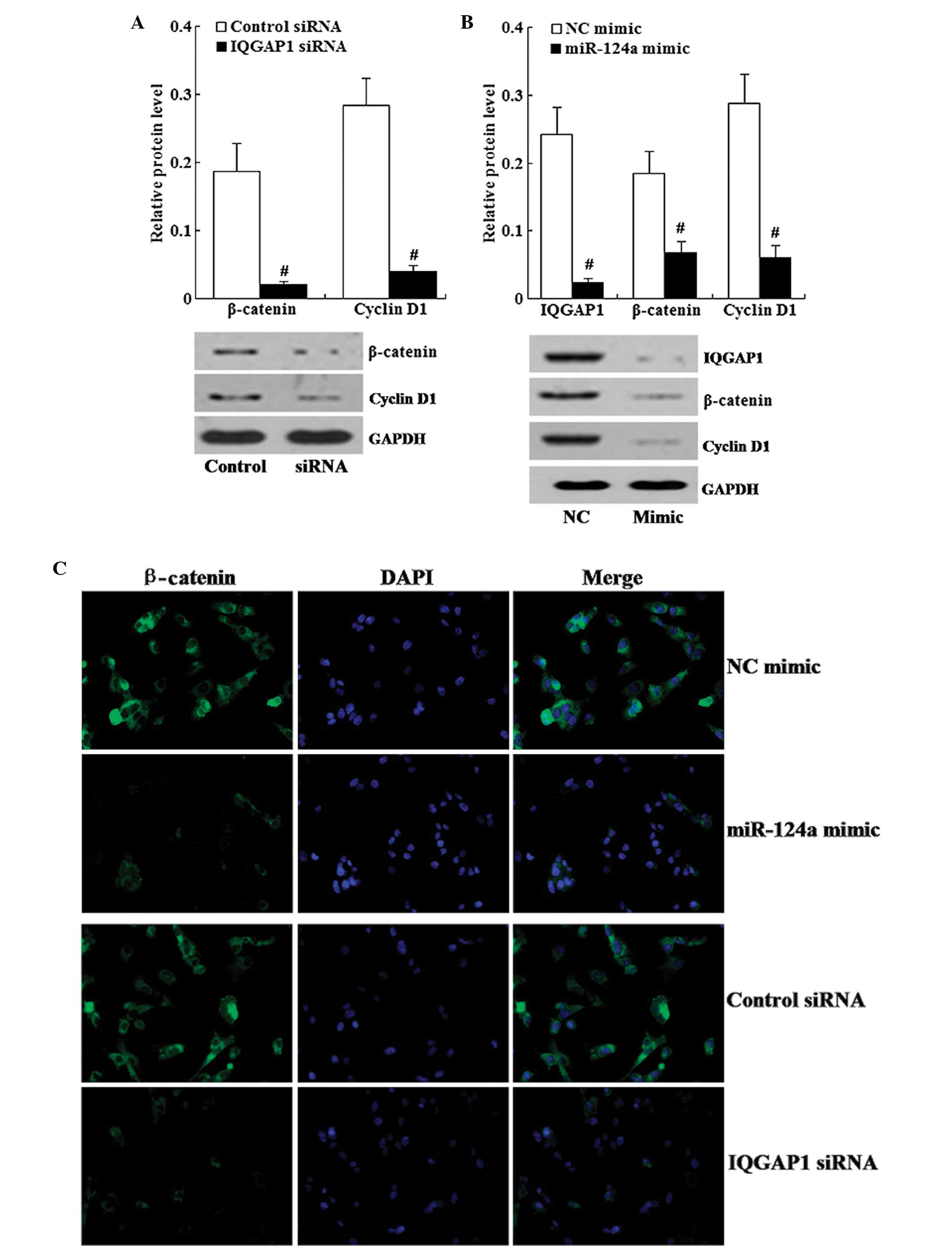miR-124a restoration inhibits glioma cell proliferation and invasion by suppressing IQGAP1 and β-catenin
- Authors:
- Published online on: August 29, 2014 https://doi.org/10.3892/or.2014.3455
- Pages: 2104-2110
Abstract
Introduction
Gliomas account for 80% of all primary brain and central nervous system malignancies (1). Gliomas are difficult to be cured by surgical resection or radiotherapy, and the median survival of patients with gliomas is only 12–15 months (2). Therefore, it is necessary to elucidate the underlying mechanisms involved in glioma development and to discover new targets for the treatment of gliomas.
Accumulating evidence suggests that changes in the expression of microRNAs (miRNAs) are associated with cancer development (3), and a number of miRNAs have been identified to be important regulators of tumorigenesis (4,5).
Previous research has shown that miR-124 is abundantly expressed in normal brain tissue (6); however, only a few reports have focused on the biological impact of miR-124 on glioma cells (7) and the underlying mechanisms need to be elucidated.
In the present study, we investigated the role of miR-124a in glioma proliferation and invasion. The in vivo study demonstrated that expression of miR-124a was downregulated in glioma tissues and in highly malignant glioma cells. Restoration of miR-124a or the knockdown of IQGAP1 in vitro inhibited glioma cell proliferation and invasion. Furthermore, we confirmed that miR-124a could inhibit glioma cell proliferation and invasion by blocking the expression of the IQGAP1 gene and downstream β-catenin and cyclin D1.
Materials and methods
Cell culture
Human glioma cell lines (U251, U343, U87, SF126 and SF76) were purchased from the American Type Culture Collection (ATCC; Manassas, VA, USA) and cultured in Dulbecco’s modified Eagle’s medium (DMEM; Gibco, Grand Island, NY, USA) supplemented with 10% fetal bovine serum (Gibco) at 37°C in a humidified atmosphere of 5% CO2.
Tissue samples
This study was approved by the Ethics Committee of the Third Xiangya Hospital of Central South University. All patients provided written informed consent in compliance with the code of ethics of the World Medical Association (Declaration of Helsinki). Human glioma samples and adjacent normal tissue samples were collected from 20 glioma patients who underwent surgery at the Neurosurgery Department of the Third Xiangya Hospital of Central South University (Changsha, Hunan, China). At the time of diagnosis, 10 patients had early stage (I, II) whereas the other 10 patients had stage III and IV glioma. The tissue samples were obtained from surgery and immediately frozen in liquid nitrogen.
Real-time PCR
Total RNAs were isolated from cells and tissues using TRIzol (Invitrogen, Carlsbad, CA, USA) according to the manufacturer’s instructions. Reverse transcription was performed using a RevertAid™ First Strand cDNA Synthesis kit (Fermentas, Vilnius, Lithuania). Real-time PCR reaction was carried out in a 7900 Sequence Detection System (Applied Biosystems, Foster City, CA, USA) using a SYBR-Green PCR kit (Applied Biosystems). The relative mRNA expression level was calculated by the comparative Ct method.
Western blotting
Tissues and cells were lysed by ice-cold protein extraction buffer (150 mM Tris-HCl, pH 7.4, 120 mM NaCl, 2 mM EDTA, 50 mM sodium fluoride, 0.2% SDS, 1% Nonidet P-40, 100 mM sodium vanadate and 1 mM phenylmethylsulfonyl fluoride). Proteins were quantitated using the BCA kit (Beyotime, Shanghai, China). The protein samples were separated in 10% SDS-PAGE and transferred onto a nitrocellulose membrane (Millipore, Billerica, MA, USA). The membranes were blocked overnight in 5% non-fat milk and then incubated with the primary antibody [IQGAP1 and β-catenin antibodies (Abcam, Cambridge, MA, USA); p-β-catenin and cyclin D1 antibodies (Cell Signaling Technology, Inc., Beverly, MA, USA); GAPDH antibody (Santa Cruz Biotechnology, Inc., Santa Cruz, CA, USA)] for 1 h at room temperature. After washing with PBS, the membranes were incubated with the secondary antibody [HRP-conjugated goat anti-mouse IgG and HRP-conjugated goat anti-rabbit IgG (Santa Cruz Biotechnology, Inc.)] for 1 h at room temperature. Detection was performed using a chemiluminescence-based detection system (ECL western blotting kit; Pierce Biotechnology, Inc., Rockford, IL, USA).
Immunofluorescence
Cells were washed with PBS and fixed in 4% paraformaldehyde solution for 1 h. After permeabilization with 0.2% Triton X-100 at 4°C for 1 h, cells were blocked with goat serum and then incubated with the primary antibody (β-catenin antibody) for 1 h at 37°C. Subsequently, the secondary antibody [Alexa Fluor 488-labeled anti-rabbit IgG (Cell Signaling Technology Inc.)] was added, and the cells were incubated at 37°C for 1 h. DAPI (Santa Cruz Biotechnology, Inc.) was used to label the nucleus, and the cells were visualized by fluorescence microscopy (Nikon, Tokyo, Japan).
Transfection
The miR-124a mimic and siRNAs were synthesized by Biomics Biotechnologies Inc. (Nantong, Jiangsu, China). Cells were transfected with the miR-124a mimic or siRNAs using Lipofectamine 2000 (Invitrogen, Carlsbad, CA, USA) following the manufacturer’s instructions. After 6 h, the cultures were replaced with fresh medium.
Luciferase assay
The pRL-TK Renilla luciferase reporter vector, pmirGLO luciferase reporter vector and Dual-luciferase reporter assay system were purchased from Promega (Madison, WI, USA). Reporter plasmids containing the 3′UTR of IQGAP1 (pmirGLO-IQGAP1) were co-transfected with the NC mimic or the miR-124a mimic into cells. pRL-TK Renilla luciferase reporter vector was used as an internal control. Luciferase activity was measured by the Dual-luciferase reporter assay system. Results were expressed as the firefly luciferase activity normalized to Renilla luciferase activity.
MTT assay
The MTT assay was used to assess cell proliferation. Cells were seeded in 96-well plates and allowed to grow for 24 h. After transfection, 50 μl MTT solution was added and incubated at 37°C for 4 h. After dissolving the formazine granulars with 150 μl DMSO, the optical density (OD) at 570 nm was measured using a microplate reader (Ascent 354; Thermo Labsystems, Waltham, MA, USA).
Transwell-Matrigel invasion assay
Transwell inserts (Corning) were coated with Matrigel (BD Biosciences, Franklin Lakes, NJ, USA) at 37°C for 30 min. The cells were suspended in serum-free medium at a final density of 5×104 cells/ml and seeded to the upper chambers. Cell medium containing 10% FBS was added to the lower chambers. After incubation at 37°C for 12 h, non-invaded cells were removed by a cotton swab. The invaded cells were fixed in 95% ethanol for 20 min, followed by staining with hematoxylin for 10 min. The number of invaded cells was counted under an inverted microscope (Nikon).
Statistical analysis
The Student’s t-test was used to analyze differences between two groups. Data are expressed as the mean ± SD of at least three independent experiments. P<0.05 was defined as statistically significant.
Results
Expression of miR-124a in glioma tissue samples and glioma cell lines
The expression level of miR-124a in the clinical tissue specimens was determined by real-time PCR. The clinical glioma tissue samples were divided into two groups: low grade gliomas (grades I–II) and high grade gliomas (grades III–IV). As shown in Fig. 1A, the expression level of miR-124a in the glioma tissues was decreased when compared with the level in the normal tissues, and the expression level of miR-124a in the high grade gliomas was lower than that in the low grade gliomas.
We detected the expression level of miR-124a in a series of human glioma cell lines (U251, U343, U87, SF126, SF767). The results revealed that the expression level of miR-124a was lowest in the highly malignant glioma cell line U87 (Fig. 1B).
Expression of IQGAP1, β-catenin and phospho-β-catenin in glioma tissue samples and glioma cell lines
Expression of IQGAP1, β-catenin and phospho-β-catenin in the glioma tissue samples was determined by western blot analysis. The results revealed that the relative protein levels of IQGAP1 and β-catenin were increased in the glioma tissues when compared with the levels in the normal tissues. However, the relative protein level of phospho-β-catenin in the glioma tissues was lower than that in the normal tissues (Fig. 1C).
In addition, expression levels of IQGAP1, β-catenin and phospho-β-catenin were examined in a series of human glioma cell lines. As shown in Fig. 1D, U87 cells had high levels of IQGAP1 and β-catenin, but a low expression level of phospho-β-catenin. Based on the low expression level of miR-124a and high expression level of IQGAP1, we conducted miR-124a restoration and IQGAP1 knockdown on U87 cells for the following study in vitro.
miR-124a restoration inhibits cell proliferation and invasion
To investigate the effects of miR-124a restoration on glioma cells, the miR-124a mimic was transfected into U87 cells. As shown in Fig. 2A, the expression level of miR-124a was higher in the miR-124a mimic group than that in the control group.
The proliferation rate of the U87 cells was determined using the MTT assay. As shown in Fig. 2B, the cells transfected with the miR-124a mimic proliferated at a significantly lower rate compared with the blank and NC mimic-transfected cells. In addition, the cell invasion assay revealed that the number of invaded cells was significantly decreased in the miR-124a mimic group compared with the number in the NC mimic group (Fig. 2C).
Effect of IQGAP1 knockdown on cell proliferation and invasion
U87 cells were transfected with siRNA to knock down IQGAP1 expression. As shown in Fig. 3A and B, IQGAP1 expression was successfully reduced by siRNAs as determined using real-time PCR and western blot analyses.
Next, cells transfected with siRNA#1 were subjected to the MTT and cell invasion assays. As shown in Fig. 3C and D, U87 cells with reduced IQGAP1 showed decreased cell proliferation and invasion ability in comparison to the control cells.
IQGAP1 is a direct target of miR-124a in the U87 cells
In order to further validate the relationship between miR-124a and IQGAP1, we carried out the IQGAP1 3′UTR reporter assay in U87 cells. The results revealed that luciferase activity was significantly decreased in the U87 cells transfected with the miR-124a mimic and wild-type IQGAP1-3′UTR, but no reduction was observed in the mutant IQGAP1-3′UTR (Fig. 4). The results demonstrated that IQGAP1 is a direct target of miR-124a.
Effect of IQGAP1 knockdown on the expression of β-catenin and cyclin D1
We tested whether IQGAP1 knockdown could affect the expression of β-catenin and cyclin D1. As shown in Fig. 5A, western blot analysis revealed that IQGAP1 knockdown resulted in decreased expression of β-catenin and cyclin D1.
In addition, immunofluorescence staining showed that in the IQGAP1 siRNA group, β-catenin was localized in the cytoplasm, and the staining of β-catenin was weaker in the IQGAP1 knockdown cells compared with the staining in the control cells (Fig. 5C).
miR-124a restoration downregulates the expression of IQGAP1, β-catenin and cyclin D1
We examined the effects of miR-124a restoration on the expression of IQGAP1, β-catenin and cyclin D1. Western blot analysis demonstrated that miR-124a restoration led to decreased expression of IQGAP1, β-catenin and cyclin D1 (Fig. 5B).
As shown in Fig. 5C, immunofluorescence staining of β-catenin revealed that compared with the miR-124a NC-transfected cells, β-catenin was localized in the cytoplasm and the staining of β-catenin was weaker in the miR-124a mimic-transfected cells.
Discussion
MicroRNAs (miRNAs) are a class of ~22 nt long non-coding RNAs which regulate target mRNAs by interacting with the 3′UTR (8). They play important roles in numerous biological processes, such as proliferation, differentiation, development, immunology and cell death (9–14). An increasing number of studies have revealed that aberrant miRNA expression is related to cancer biology, acting as either tumor suppressors or oncogenes (4,5,15).
microRNA-124 (miR-124) has been classified as a tumor suppressor in several types of human cancers (16–18). Previous research has shown that miR-124 is abundantly expressed in normal brain tissue (6), is involved in embryonic neuronal differentiation (19), and is an important regulator of adult neurogenesis in the subventricular zone stem cell niche (20). The present study demonstrated that miR-124a expression is downregulated in human glioma tissues and its expression level is negatively correlated with the pathological grade of glioma. Furthermore, the in vitro study revealed that miR-124a restoration inhibited glioma cell proliferation and invasion. This indicates that miR-124a acts as a tumor suppressor in gliomas.
IQ motif containing GTPase activating protein 1 (IQGAP1) is a member of the IQGAP family. It regulates actin dynamics and cell motility (21,22) by interacting with cytoskeleton components, cell adhesion molecules and several signaling molecules (23). IQGAP1 is important for normal cellular function and homeostasis. Amplification and overexpression of IQGAP1 were reported to be associated with certain malignancies (24–28). IQGAP1 localizes to sites of cell-cell contact (29) and regulates cell-cell adhesion via interacting with E-cadherin and β-catenin. β-catenin is the central denominator of the Wnt pathway and plays roles in various types of cancer (30). Cytoplasmic β-catenin is associated with APC and Axin and forms a destruction complex on which β-catenin is phosphorylated by the kinases CK1α and GSK3β, leading to β-catenin degradation by the ubiquitin-proteasome mechanism. Disruption of β-catenin degradation inhibits β-catenin phosphorylation and leads to the translocation of β-catenin into nuclei, where it activates an array of target genes and cell cycle regulators such as c-myc and cyclin D1 (31,32). Given the important role of β-catenin in cancer, it is of particular interest to identify regulators that may interfere with β-catenin signaling and thereby lead to cancer development, in particular those miRNAs that can simultaneous interact with multiple regulators of the β-catenin pathway. In the present study, examination of clinical samples of gliomas showed that IQGAP1 and β-catenin were upregulated in the glioma tissues, while phospho-β-catenin was downregulated in the glioma tissues. Furthermore, the in vitro study revealed that IQGAP1 knockdown led to decreased cell proliferation and invasion. Next, molecular mechanisms underlying glioma cell proliferation and invasion were studied. RNA interference assay showed that IQGAP1 regulated the expression of β-catenin in glioma cells. IQGAP1 knockdown resulted in the downregulation of β-catenin and cyclin D1. Luciferase assay demonstrated that IQGAP1 is a direct target of miR-124a. Overall, the present study demonstrated that miR-124a inhibits cell proliferation and invasion in glioma cells by targeting IQGAP1, consequently suppressing β-catenin and downstream cyclin D1.
Our study uncovered a novel molecular mechanism underlying glioma cell proliferation and invasion and may provide a useful molecular therapy for gliomas.
References
|
Dolecek TA, Propp JM, Stroup NE and Kruchko C: CBTRUS statistical report: primary brain and central nervous system tumors diagnosed in the United States in 2005–2009. Neuro Oncol. 14(Suppl 5): v1–v49. 2012.PubMed/NCBI | |
|
Louis DN, Ohgaki H, Wiestler OD, et al: The 2007 WHO classification of tumours of the central nervous system. Acta Neuropathol. 114:97–109. 2007. View Article : Google Scholar : PubMed/NCBI | |
|
Volinia S, Calin GA, Liu CG, et al: A microRNA expression signature of human solid tumors defines cancer gene targets. Proc Natl Acad Sci USA. 103:2257–2261. 2006. View Article : Google Scholar : PubMed/NCBI | |
|
Esquela-Kerscher A and Slack FJ: Oncomirs - microRNAs with a role in cancer. Nat Rev Cancer. 6:259–269. 2006. View Article : Google Scholar | |
|
Hammond SM: MicroRNAs as oncogenes. Curr Opin Genet Dev. 16:4–9. 2006. View Article : Google Scholar | |
|
Lagos-Quintana M, Rauhut R, Yalcin A, Meyer J, Lendeckel W and Tuschl T: Identification of tissue-specific microRNAs from mouse. Curr Biol. 12:735–739. 2002. View Article : Google Scholar : PubMed/NCBI | |
|
An L, Liu Y, Wu A and Guan Y: microRNA-124 inhibits migration and invasion by down-regulating ROCK1 in glioma. PLoS One. 8:e694782013. View Article : Google Scholar : PubMed/NCBI | |
|
Bartel DP: MicroRNAs: genomics, biogenesis, mechanism, and function. Cell. 116:281–297. 2004. View Article : Google Scholar : PubMed/NCBI | |
|
Li Q, Bian S, Hong J, et al: Timing specific requirement of microRNA function is essential for embryonic and postnatal hippocampal development. PLoS One. 6:e260002011. View Article : Google Scholar : PubMed/NCBI | |
|
Chen CZ, Li L, Lodish HF and Bartel DP: MicroRNAs modulate hematopoietic lineage differentiation. Science. 303:83–86. 2004. View Article : Google Scholar : PubMed/NCBI | |
|
Brennecke J, Hipfner DR, Stark A, Russell RB and Cohen SM: bantam encodes a developmentally regulated microRNA that controls cell proliferation and regulates the proapoptotic gene hid in Drosophila. Cell. 113:25–36. 2003. View Article : Google Scholar | |
|
Chen CH, Guo M and Hay BA: Identifying microRNA regulators of cell death in Drosophila. Methods Mol Biol. 342:229–240. 2006.PubMed/NCBI | |
|
Fu LL, Wen X, Bao JK and Liu B: MicroRNA-modulated autophagic signaling networks in cancer. Int J Biochem Cell Biol. 44:733–736. 2012. View Article : Google Scholar : PubMed/NCBI | |
|
Ambros V: The functions of animal microRNAs. Nature. 431:350–355. 2004. View Article : Google Scholar : PubMed/NCBI | |
|
Medina PP and Slack FJ: microRNAs and cancer: an overview. Cell Cycle. 7:2485–2492. 2008. View Article : Google Scholar : PubMed/NCBI | |
|
Xia J, Wu Z, Yu C, et al: miR-124 inhibits cell proliferation in gastric cancer through down-regulation of SPHK1. J Pathol. 227:470–480. 2012. View Article : Google Scholar : PubMed/NCBI | |
|
Lang Q and Ling C: MiR-124 suppresses cell proliferation in hepatocellular carcinoma by targeting PIK3CA. Biochem Biophys Res Commun. 426:247–252. 2012. View Article : Google Scholar : PubMed/NCBI | |
|
Lv XB, Jiao Y, Qing Y, et al: miR-124 suppresses multiple steps of breast cancer metastasis by targeting a cohort of pro-metastatic genes in vitro. Chin J Cancer. 30:821–830. 2011. View Article : Google Scholar : PubMed/NCBI | |
|
Cao X, Pfaff SL and Gage FH: A functional study of miR-124 in the developing neural tube. Genes Dev. 21:531–536. 2007. View Article : Google Scholar : PubMed/NCBI | |
|
Cheng LC, Pastrana E, Tavazoie M and Doetsch F: miR-124 regulates adult neurogenesis in the subventricular zone stem cell niche. Nat Neurosci. 12:399–408. 2009. View Article : Google Scholar : PubMed/NCBI | |
|
Watanabe T, Wang S, Noritake J, et al: Interaction with IQGAP1 links APC to Rac1, Cdc42, and actin filaments during cell polarization and migration. Dev Cell. 7:871–883. 2004. View Article : Google Scholar : PubMed/NCBI | |
|
Mataraza JM, Briggs MW, Li Z, Entwistle A, Ridley AJ and Sacks DB: IQGAP1 promotes cell motility and invasion. J Biol Chem. 278:41237–41245. 2003. View Article : Google Scholar : PubMed/NCBI | |
|
Nieto MA: The snail superfamily of zinc-finger transcription factors. Nat Rev Mol Cell Biol. 3:155–166. 2002. View Article : Google Scholar : PubMed/NCBI | |
|
Nabeshima K, Shimao Y, Inoue T and Koono M: Immunohistochemical analysis of IQGAP1 expression in human colorectal carcinomas: its overexpression in carcinomas and association with invasion fronts. Cancer Lett. 176:101–109. 2002. View Article : Google Scholar : PubMed/NCBI | |
|
Dong P, Nabeshima K, Nishimura N, Kawakami T, Hachisuga T, Kawarabayashi T and Iwasaki H: Overexpression and diffuse expression pattern of IQGAP1 at invasion fronts are independent prognostic parameters in ovarian carcinomas. Cancer Lett. 243:120–127. 2006. View Article : Google Scholar : PubMed/NCBI | |
|
Balenci L, Clarke ID, Dirks PB, et al: IQGAP1 protein specifies amplifying cancer cells in glioblastoma multiforme. Cancer Res. 66:9074–9082. 2006. View Article : Google Scholar : PubMed/NCBI | |
|
Johnson M, Sharma M and Henderson BR: IQGAP1 regulation and roles in cancer. Cell Signal. 21:1471–1478. 2009. View Article : Google Scholar | |
|
Nakamura H, Fujita K, Nakagawa H, Kishi F, Takeuchi A, Aute I and Kato H: Expression pattern of the scaffold protein IQGAP1 in lung cancer. Oncol Rep. 13:427–431. 2005.PubMed/NCBI | |
|
Kuroda S, Fukata M, Nakagawa M, et al: Role of IQGAP1, a target of the small GTPases Cdc42 and Rac1, in regulation of E-cadherin-mediated cell-cell adhesion. Science. 281:832–835. 1998. View Article : Google Scholar : PubMed/NCBI | |
|
Polakis P: Wnt signaling and cancer. Genes Dev. 14:1837–1851. 2000. | |
|
Breuhahn K, Longerich T and Schirmacher P: Dysregulation of growth factor signaling in human hepatocellular carcinoma. Oncogene. 25:3787–3800. 2006. View Article : Google Scholar : PubMed/NCBI | |
|
Lee HC, Kim M and Wands JR: Wnt/Frizzled signaling in hepatocellular carcinoma. Front Biosci. 11:1901–1915. 2006. View Article : Google Scholar : PubMed/NCBI |



